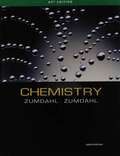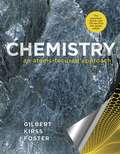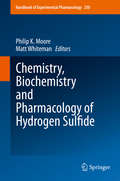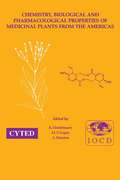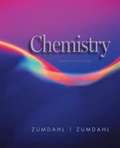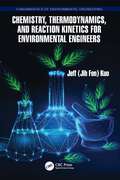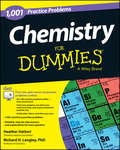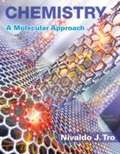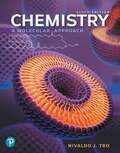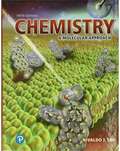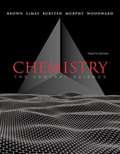- Table View
- List View
Chemistry, AP* Edition
by Steven S. Zumdahl Susan A. ZumdahlThis fully updated Ninth Edition of Steven and Susan Zumdahl's CHEMISTRY brings together the solid pedagogy, easy-to-use media, and interactive exercises that today's instructors need for their general chemistry course. Rather than focusing on rote memorization, CHEMISTRY uses a thoughtful approach built on problem-solving. For the Ninth Edition, the authors have added a new emphasis on critical systematic problem solving, new critical thinking questions, and new computer-based interactive examples to help students learn how to approach and solve chemical problems--to learn to think like chemists--so that they can apply the process of problem solving to all aspects of their lives. Students are provided with the tools to become critical thinkers: to ask questions, to apply rules and develop models, and to evaluate the outcome. In addition, Steven and Susan Zumdahl crafted ChemWork, an online program included in OWL Online Web Learning to support their approach, much as an instructor would offer support during office hours. ChemWork is just one of many study aids available with CHEMISTRY that supports the hallmarks of the textbook--a strong emphasis on models, real world applications, visual learning, and independent problem solving. Available with InfoTrac Student Collections http://gocengage. com/infotrac.
Chemistry, AP* Edition
by Steven S. Zumdahl Susan A. ZumdahlThis fully updated Ninth Edition of Steven and Susan Zumdahl's CHEMISTRY brings together the solid pedagogy, easy-to-use media, and interactive exercises that today's instructors need for their general chemistry course. Rather than focusing on rote memorization, CHEMISTRY uses a thoughtful approach built on problem-solving. For the Ninth Edition, the authors have added a new emphasis on critical systematic problem solving, new critical thinking questions, and new computer-based interactive examples to help students learn how to approach and solve chemical problems--to learn to think like chemists--so that they can apply the process of problem solving to all aspects of their lives. Students are provided with the tools to become critical thinkers: to ask questions, to apply rules and develop models, and to evaluate the outcome. In addition, Steven and Susan Zumdahl crafted ChemWork, an online program included in OWL Online Web Learning to support their approach, much as an instructor would offer support during office hours. ChemWork is just one of many study aids available with CHEMISTRY that supports the hallmarks of the textbook--a strong emphasis on models, real world applications, visual learning, and independent problem solving. Available with InfoTrac Student Collections http://gocengage. com/infotrac.
Chemistry, An Atom Focused Approach
by Thomas R. Gilbert Rein V. Kirss Natalie Foster Geoffrey DaviesThe book intends to enable the students to be able to interpret and even predict the physical and chemical properties of substances based on their atomic and molecular structures, and to understand how chemistry is linked to other scientific disciplines.
Chemistry, Biochemistry and Pharmacology of Hydrogen Sulfide (Handbook of Experimental Pharmacology #230)
by Philip K. Moore Matt WhitemanThis book puts hydrogen sulfide in context with other gaseous mediators such as nitric oxide and carbon monoxide, reviews the available mechanisms for its biosynthesis and describes its physiological and pathophysiological roles in a wide variety of disease states. Hydrogen sulfide has recently been discovered to be a naturally occurring gaseous mediator in the body. Over a relatively short period of time this evanescent gas has been revealed to play key roles in a range of physiological processes including control of blood vessel caliber and hence blood pressure and in the regulation of nerve function both in the brain and the periphery. Disorders concerning the biosynthesis or activity of hydrogen sulfide may also predispose the body to disease states such as inflammation, cardiovascular and neurological disorders. Interest in this novel gas has been high in recent years and many research groups worldwide have described its individual biological effects. Moreover, medicinal chemists are beginning to synthesize novel organic molecules that release this gas at defined rates with a view to exploiting these new compounds for therapeutic benefit.
Chemistry, Biological and Pharmacological Properties of Medicinal Plants from the Americas
by Kurt HostettmannThis volume is a compilation of plenary lectures presented at the IOCD/CYTED Symposium held in Panama City, Panama in 1997, and covers different aspects of research into plants from North, South and Central America. The topics treated all revolve around the chemistry, pharmacology, and biology of these plants. The importance of pharmaceuticals derived from plant sources is described, together with the potential of ethnomedicine for providing new leads in the search for bioactive constituents. The biodiversity of the Americas is underlined and an idea is given of the urgency with which the flora must be studied.
Chemistry, Biology and Pharmacology of Lichen
by Ajay Sharma Mohammad Javed Ansari Garima Bhardwaj Ashoke Kumar Das Deepika KathuriaUnderstand the properties and applications of one of the world’s most ubiquitous flora Lichen is a single entity comprising two or more organisms—most typically algae and fungus—in a symbiotic relationship. It is one of the planet’s most abundant categories of flora, with over 25,000 known species across all regions of the globe. Lichens’ status as a rich source of bioactive metabolites and phytochemicals, as well as their potential as bio-indicators, has given them an increasingly prominent role in modern research into medicine, cosmetics, food, and more. Chemistry, Biology and Pharmacology of Lichen provides a comprehensive overview of these bountiful flora and their properties. It provides not only in-depth analysis of lichen physiology and ecology, but also a thorough survey of their modern and growing applications. It provides all the tools readers need to domesticate lichen and bring their properties to bear on some of humanity’s most intractable scientific problems. Chemistry, Biology and Pharmacology of Lichen readers will also find: Applications of lichen in fields ranging from food to cosmetics to nanoscience and beyond Detailed discussion of topics including lichen as habitats for other organisms, lichens as anticancer drugs, antimicrobial properties of lichen, and many more Detailed discussion on key bioactive compounds from lichens Chemistry, Biology and Pharmacology of Lichen is ideal for scientists and researchers in ethnobotany, pharmacology, chemistry, and biology, as well as teachers and students with an interest in biologically important lichens.
Chemistry, Module J (HMH Science Dimensions™)
by Marjorie Frank Michael R. Heithaus Michael A. DiSpezioNIMAC-sourced textbook
Chemistry, Precision and Design
by Gregory Parker Verne BiddleGive your students a college-prep science education with Chemistry: Precision and Design. The text teaches students the basic principles of chemistry in an understandable and interesting manner. Abundant photographs, illustrations, and diagrams make chemical principles and applications clear and understandable as students learn about matter, stoichiometry, gases, chemical thermodynamics, chemical kinetics, nuclear and organic chemistry, and more. <p><p>Teaching students to see science as a way to bring glory to God, this text treats environmental issues such as ozone depletion, global warming, and nuclear power from a conservative perspective. In-text learning aids are integrated throughout, including key concepts, chapter outlines, worked examples, exercises keyed to the examples, "Chemistry in Action" examples, and chapter summaries.
Chemistry, Study Guide
by Paul B. KelterReflects the unique problem-solving approach of the book. Includes alternate problem solving strategies, supplemental explanations, summaries of chapter sections, 400 worked examples, 800 self-practice tests, and answers to the exercises and self-tests--all designed to help students master the text material.
Chemistry, Thermodynamics, and Reaction Kinetics for Environmental Engineers (Fundamentals of Environmental Engineering)
by Jeff KuoThis book aims to be the preeminent university chemistry textbook for environmental engineers. It provides undergraduate and graduate environmental engineering students with basic concepts and practical knowledge about chemistry that they would need in their professional careers. It focuses on the fundamental concepts of chemistry and its practical applications (e.g., understanding fate and transport of chemicals/pollutants in the environmental as well as the chemical/physicochemical processes applied in environmental engineering industry). This book also serves as a valuable resource for entry-level professionals to solidify their fundamental knowledge in environmental engineering chemistry. This book Presents the fundamentals of chemistry with focus on the needs of environmental engineers. Explains how an understanding of chemistry allows readers a better understanding of the fate and transport of chemicals in the environment as well as various treatment processes. Examines the fundamentals of chemical reaction equilibrium from learning the basics of thermodynamics. Presents the basic types and designs of reactors as well as reaction kinetics.
Chemistry: 1,001 Practice Problems For Dummies (+ Free Online Practice)
by Richard H. Langley Heather HattoriPractice makes perfect--and helps deepen your understanding of chemistry Every high school requires a course in chemistry, and many universities require the course for majors in medicine, engineering, biology, and various other sciences. 1001 Chemistry Practice Problems For Dummies provides students of this popular course the chance to practice what they learn in class, deepening their understanding of the material, and allowing for supplemental explanation of difficult topics. 1001 Chemistry Practice Problems For Dummies takes you beyond the instruction and guidance offered in Chemistry For Dummies, giving you 1,001 opportunities to practice solving problems from the major topics in chemistry. Plus, an online component provides you with a collection of chemistry problems presented in multiple-choice format to further help you test your skills as you go.Gives you a chance to practice and reinforce the skills you learn in chemistry classHelps you refine your understanding of chemistryPractice problems with answer explanations that detail every step of every problemWhether you're studying chemistry at the high school, college, or graduate level, the practice problems in 1001 Chemistry Practice Problems For Dummies range in areas of difficulty and style, providing you with the practice help you need to score high at exam time.
Chemistry: 1001 Practice Problems For Dummies (+ Free Online Practice)
by Richard H. Langley Heather HattoriPractice your way to a better grade in your Chemistry class Chemistry: 1001 Practice Problems For Dummies gives you 1,001 opportunities to practice solving problems on all the topics covered in your chemistry class—in the book and online! Get extra practice with tricky subjects, solidify what you’ve already learned, and get in-depth walk-throughs for every problem with this useful book. These practice problems and detailed answer explanations will catalyze the reactions in your brain, no matter what your skill level. Thanks to Dummies, you have a resource to help you put key concepts into practice. Work through multiple-choice practice problems on all Chemistry topics covered in class Step through detailed solutions to build your understanding Access practice questions online to study anywhere, any time Improve your grade and up your study game with practice, practice, practiceThe material presented in Chemistry: 1001 Practice Problems For Dummies is an excellent resource for students, as well as parents and tutors looking to help supplement classroom instruction. Chemistry: 1001 Practice Problems For Dummies (9781119883531) was previously published as 1,001 Chemistry Practice Problems For Dummies (9781118549322). While this version features a new Dummies cover and design, the content is the same as the prior release and should not be considered a new or updated product.
Chemistry: A Contemporary Approach
by Paul S. Cohen Paul S. GeffnerThis book is designed to make learning easier for students. Its content is carefully selected and logically organized. It offers a shortened introductory chemistry course.
Chemistry: A Foundation
by Steven S. Zumdahl Donald J. DeCoste Zumdahl Digital Consultant and Contributor Gretchen AdamsLearn the skills you need to succeed in your chemistry course with CHEMISTRY, Tenth Edition. <p><p>This trusted text has helped generations of students learn to think like chemists and develop problem-solving skills needed to master even the most challenging problems. Clear explanations and interactive examples help you build confidence for the exams, so that you can study to understand rather than simply memorize. Combined with the online resources and instant feedback in OWLv2, you'll be on your way to developing a deeper understanding of chemistry concepts and solving complex problems in all aspects of your life.
Chemistry: A Molecular Approach
by Nivaldo J. TroThe Fourth Edition of Niva Tro's Chemistry: A Molecular Approach reinforces development of 21st century skills including data interpretation and analysis, problem solving and quantitative reasoning, applying conceptual understanding to new situations and peer-to-peer collaboration. Nivaldo Tro presents chemistry visually through multi-level images-macroscopic, molecular, and symbolic representations-helping readers see the connections between the world they see around them (macroscopic), the atoms and molecules that compose the world (molecular), and the formulas they write down on paper (symbolic). The benefits of Dr. Tro's problem-solving approach are reinforced through digital, Interactive Worked Examples that provide an office-hour type of environment and expanded coverage on the latest developments in chemistry. New Key Concept Videos explain difficult concepts while new end-of-chapter problems including Group Work questions and Data Interpretation and Analysis questions engage readers in applying their understanding of chemistry. The revision has been constructed to easily incorporate material to engage readers.
Chemistry: A Molecular Approach
by Nivaldo J. TroChemistry: A Molecular Approach presents chemistry visually through macroscopic, molecular and symbolic multi-level images to help you see the connections between chemistry and the world around you. Author Nivaldo Tro uses a consistent problem-solving approach (Sort, Strategize, Solve and Check) throughout the text to show how to analyze a problem and devise a solution strategy. His consistent problem-solving approach and active learning resources are designed to engage you in becoming an expert problem solver and critical thinker. <p><p>The 6th Edition presents interactive digital features to guide you through key concepts and the problem-solving process. Updates reflect current research on the COVID-19 vaccine and an extensive diversity, equity and inclusion review.
Chemistry: A Molecular Approach
by Nivaldo J. TroChemistry: A Molecular Approach presents chemistry visually through macroscopic, molecular and symbolic multi-level images to help you see the connections between chemistry and the world around you. Author Nivaldo Tro uses a consistent problem-solving approach (Sort, Strategize, Solve and Check) throughout the text to show how to analyze a problem and devise a solution strategy. His consistent problem-solving approach and active learning resources are designed to engage you in becoming an expert problem solver and critical thinker. The 6th Edition presents interactive digital features to guide you through key concepts and the problem-solving process. Updates reflect current research on the COVID-19 vaccine and an extensive diversity, equity and inclusion review.
Chemistry: A Molecular Approach
by Nivaldo TroNivaldo Tro’s Chemistry: A Molecular Approach presents chemistry visually through multi-level images―macroscopic, molecular, and symbolic representations―to help students see the connections between the world they see around them, the atoms and molecules that compose the world, and the formulas they write down on paper. Interactive, digital versions of select worked examples instruct students how to break down problems using Tro’s unique “Sort, Strategize, Solve, and Check” technique and then complete a step in the example. To build conceptual understanding, Dr. Tro employs an active learning approach through interactive media that requires students to pause during videos to ensure they understand before continuing. <p><p>The 5th Edition pairs digital, pedagogical innovation with insights from learning design and educational research to create an active, integrated, and easy-to-use framework. The new edition introduces a fully integrated book and media package that streamlines course set up, actively engages students in becoming expert problem solvers, and makes it possible for professors to teach the general chemistry course easily and effectively.
Chemistry: A Molecular Approach (AP Edition)
by Nivaldo J. TroA student oriented book that provides relevant information that will motivate and get them to achieve the highest possible level in chemistry.
Chemistry: A Molecular Approach, 3rd Edition
by Nivaldo J. TroChemistry: A Molecular Approach, Third Edition is an innovative, pedagogically driven text that explains challenging concepts in a student-oriented manner. Nivaldo Tro creates a rigorous and accessible treatment of general chemistry in the context of relevance and the big picture. Chemistry is presented visually through multi-level images-macroscopic, molecular, and symbolic representations-helping students see the connections between the world they see around them (macroscopic), the atoms and molecules that compose the world (molecular), and the formulas they write down on paper (symbolic). The hallmarks of Dr. Tro's problem-solving approach are reinforced through interactive media that provide students with an office-hour type of environment built around worked examples and expanded coverage on the latest developments in chemistry. Pioneering features allow students to sketch their ideas through new problems, and much more.
Chemistry: AP Edition (10th Edition)
by Theodore L. Brown H. Eugene Lemay Jr. Bruce E. BurstenThis is the tenth edition of a text that has enjoyed unprecedented success as an AP* program over its many editions. It is fair to ask why there needs to be yet another edition. The answer in part lies in the nature of chemistry itself, a dy¬namic science in a process of continual discovery. New research leads to new applications of chemistry in other fields of science and in technology. A text¬book that purports to introduce chemistry to AP* students who have only a limited prior acquaintance with it should reflect that dynamic, changing char¬acter.
Chemistry: AP Edition (11th edition)
by Theodore L. Brown H. Eugene Lemay Jr. Bruce E. Bursten Catherine J. Murphy Patrick WoodwardChemistry: The Central Science, Eleventh Edition, has been written to introduce you to modern chemistry.
Chemistry: AP Edition (12th Edition)
by Theodore L. Brown H. Eugene Lemay Jr. Bruce E. Bursten Catherine J. Murphy Patrick WoodwardTrusted, innovative, and calibrated, Chemistry: The Central Science has helped millions of students understand and succeed in general chemistry. Its unrivaled problems, scientific accuracy, and clarity are maintained in this new edition, which is the book's biggest revision to date. In the Twelfth Edition,every word and piece of art has been studied for effectiveness. Based on feedback from students like you, this revision reflects the unparalleled expertise of its author team; each chapter has been updated and streamlined to remove any content not proven to increase student comprehension. Joined in this edition by new co-author Patrick Woodward, the book's solid authorship gains a fresh, new perspective yet maintains its unified, consistent voice.

